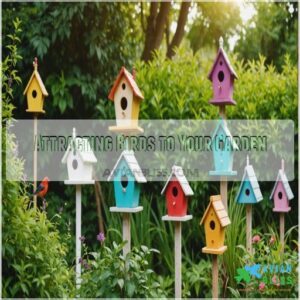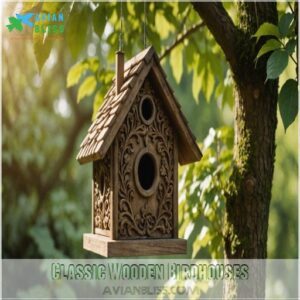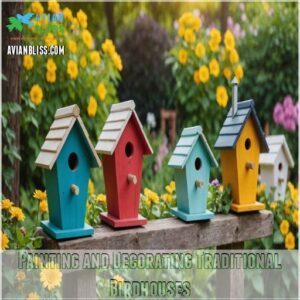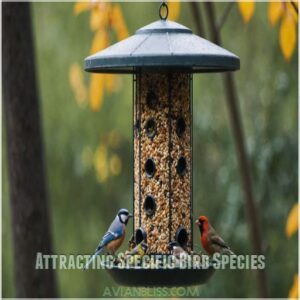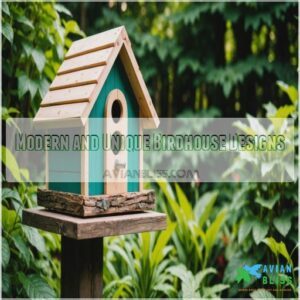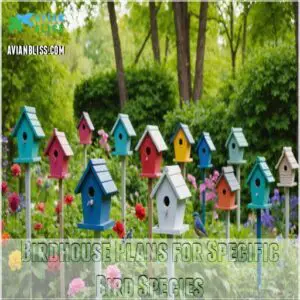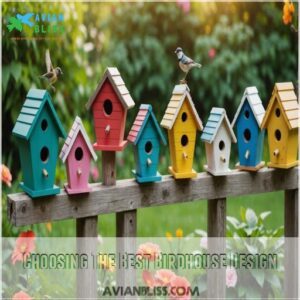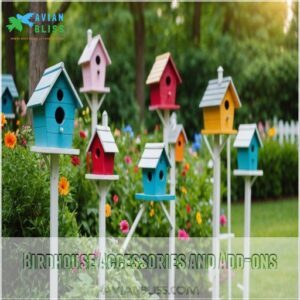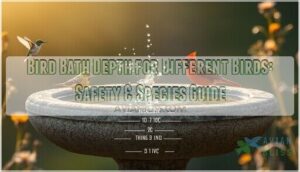This site is supported by our readers. We may earn a commission, at no cost to you, if you purchase through links.
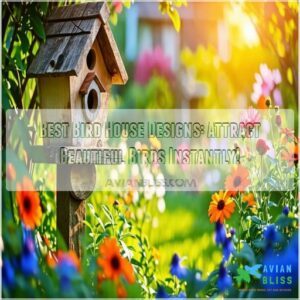
Consider classic wooden houses if you love vintage charm or opt for modern designs like the Birdball, a ceramic and wood sphere.
Different birds have unique preferences: bluebirds adore spacious quarters, while wrens prefer cozy nooks.
Placement is key—shield them from predators and too much sun. Materials range from natural woods to recycled bits.
A little care and maintenance keep these feathered guests happy.
To spice things up, explore quirky options like letter-shaped houses for a dash of whimsy.
Table Of Contents
- Key Takeaways
- Attracting Birds to Your Garden
- Traditional Birdhouse Designs
- Modern and Unique Birdhouse Designs
- Birdhouse Plans for Specific Bird Species
- Choosing The Best Birdhouse Design
- Building and Maintaining Birdhouses
- DIY Birdhouse Plans and Ideas
- Birdhouse Placement and Installation
- Birdhouse Accessories and Add-ons
- Creating a Bird-Friendly Garden
- Frequently Asked Questions (FAQs)
- What are the best Birdhouse plans?
- What is a good Birdhouse idea?
- What is a DIY Birdhouse?
- Which DIY Birdhouse Project is suitable for small birds?
- What is the best design for a birdhouse?
- What kind of birdhouses will birds actually use?
- What makes a good bird house?
- What color birdhouse attracts birds the most?
- How do weather conditions affect birdhouse durability?
- What materials are safe for birdhouse construction?
- How can birdhouses be made squirrel-proof?
- Are birdhouses beneficial for winter shelter?
- How to clean birdhouses between nesting seasons?
- Conclusion
Key Takeaways
- You should choose birdhouse designs based on the specific bird species you want to attract, considering their size and nesting preferences.
- You’ll need to select durable, weather-resistant materials like untreated wood and consider placement to protect from predators and harsh weather.
- Regular maintenance, including cleaning and repairs, is crucial for keeping your birdhouses safe and inviting for birds.
- Adding creative touches and accessories can enhance your birdhouses’ appeal and functionality, making them even more attractive to feathered friends.
Attracting Birds to Your Garden
Want to transform your garden into a bird paradise?
Just pick the right birdhouse design to welcome colorful feathered friends,
who might even return the favor by munching on those pesky insects.
Benefits of Birdhouses in Your Garden
Picture your garden buzzing with life, thanks to a cleverly placed birdhouse.
You’re not just adding charm; you’re inviting a mini ecosystem.
With birds chirping away, they’re also munching on those pesky bugs, giving you natural pest control.
It’s like installing nature’s security system while boosting your garden’s beauty and biodiversity.
Plus, birdwatching becomes your new favorite pastime!
Types of Birds You Can Attract
After you’ve relished the pest-free perks of birdhouses, let’s chat about the feathered friends you’ll attract.
Imagine your garden buzzing with bluebirds needing space, wrens craving cozy boxes, or martins wanting condos.
Each bird species has quirks, from birdhouse size to location.
Select plans that suit your space, and soon you’ll host a birdie bonanza!
Birdhouse Materials and Designs
Now that you’ve chosen which feathered friends to attract, let’s talk birdhouse materials.
Wood’s a classic, but don’t discount recycled materials for a unique, eco-friendly DIY birdhouse.
And consider using untreated wood like cedar for durability and bird safety, as seen in bird houses for small birds.
Gourd birdhouses add a rustic charm, while modern styles offer sleek aesthetics.
Simple birdhouse designs are great for beginners, and remember, the best bird house designs are those that birds love.
Consider the bird’s size when selecting your birdhouse materials and designs.
Traditional Birdhouse Designs
When you’re aiming to charm those avian guests, traditional birdhouse designs are a winner.
With their classic wooden look, they’re not just easy on the eyes but also perfect for attracting specific bird species, making your garden a hotspot for feathered friends.
Classic Wooden Birdhouses
Thinking about inviting some feathered friends to your yard?
Classic wooden birdhouses are where it’s at!
You can explore a variety of wood types and birdhouse sizes, each echoing historic designs.
These simple DIY plans make a perfect woodworking project.
Constructing a nesting box isn’t just practical—it’s a rewarding escape into creativity and hands-on fun.
Painting and Decorating Traditional Birdhouses
Imagine transforming your traditional birdhouse with a splash of creativity.
Use color palettes that mimic nature’s hues, turning them into a canvas for bird-themed art, while also incorporating functional elements like the Aivituvin Cat House Outdoor bird lover gifts.
Follow these steps:
- Choose stencils for precision designs.
- Utilize repurposed materials for unique textures.
- Incorporate DIY techniques to add a personal touch.
- Embrace birdhouse artistry for inspired birdhouse projects.
Attracting Specific Bird Species
When you’ve painted your birdhouse to match your garden vibe, focus on attracting specific bird species.
Want wrens or chickadees?
Opt for a smaller birdhouse size with a 1.25-inch entrance hole.
Purple martins require larger, multi-room houses.
Choose the right birdhouse location and material to enhance attraction.
These birdhouse tips will help your feathered friends feel right at home!
Modern and Unique Birdhouse Designs
You’re ready to give your garden a modern twist with birdhouses that look like art pieces but still attract the right birds.
From sleek metal designs to quirky recycled materials, let’s explore how to combine style and functionality without breaking a sweat—or a nail!
Contemporary Materials and Styles
Step up your backyard game with birdhouse designs that scream modern aesthetics.
Use metal birdhouses or recycled materials for an eco-friendly vibe.
Picture geometric shapes giving your garden that chic look, blending style and sustainability.
These birdhouse trends are the talk of the town, offering creativity and innovation.
You’ll love the freedom to express your taste while helping our feathered friends.
Designing Birdhouses for Specific Birds
So, you’ve got your stylish modern birdhouse materials picked out.
Now, let’s talk birdhouse design for specific species!
Birdhouse size matters; a tiny entrance hole won’t work for a large bird.
Consider the bird’s nesting material preferences too.
Location is key – think predator protection and a safe spot.
Plenty of free birdhouse plans are online, perfect for your next birdhouse project. For example, western bluebirds often require spaces with scattered trees and native shrubs, which can be considered when using free DIY bird plans.
Happy building, birdhouse enthusiasts!
Unique Birdhouse Ideas and Inspiration
Tired of the same old wooden boxes? Let your creativity soar with unique birdhouse ideas! Use recycled materials for crafty constructions or transform gourds into quirky homes.
For more inspiration, explore various bird house plans online, such as those found on bird house designs websites.
Embrace artistic designs or create birdhouse sculptures that are pure eye candy. Explore miniature houses that resemble fairy tales. Each twist on traditional designs sparks birdhouse inspiration and ingenuity!
- Recycled materials
- Gourd houses
- Artistic designs
- Birdhouse sculptures
- Miniature houses
Birdhouse Plans for Specific Bird Species
You’ve got to know the secret to attracting your favorite birds: customized birdhouse plans!
Each species has its quirks, so let’s make sure your backyard becomes their dream home by meeting those specific needs.
Bluebird Houses and Nesting Requirements
Imagine the joy when bluebirds make your custom birdhouse their new home!
For Eastern Bluebirds, a minimum interior floor space of 4 inches by 4 inches is essential for a successful bluebird house design. Choose a bluebird house size and design that fits their habitat, using natural materials.
Focus on bluebird predator protection and place houses smartly.
Check out the table below for quick guidance:
| Feature | Recommendation |
|---|---|
| Entrance Hole | 1½ inch round |
| Height | 5-10 feet above ground |
| Open Space | Yes, open fields preferred |
| Material | Untreated wood |
Robin and Cardinal Nesting Shelves
Shifting from bluebirds to robins and cardinals, it’s all about nesting shelves now.
Cardinals typically build their nests in dense shrubs and bushes, often close to the ground.
These open spaces are perfect for robins, who don’t shy away from human activity.
Cardinals? They’re trickier, preferring quiet corners.
Use sturdy materials like cedar for your DIY project.
Placement matters—think low traffic areas.
Secure your shelves, and watch as these vibrant birds settle in.
Wren and Chickadee Birdhouse Plans
If you’re charmed by the idea of wrens and chickadees flitting around, let’s craft their cozy homes.
Drill a 1.25-inch hole to keep bigger birds out.
Position your birdhouse 5-15 feet high on your yard’s edge.
DIY materials work wonders for these feathery friends.
Don’t forget winter protection, ensuring both birds can enjoy their snug havens all year!
Purple Martin Houses and Gourd Racks
From wrens to Purple Martins, creating a happy home is key.
For martins, think big: they love multifamily setups like gourd racks or DIY martin house plans.
Here’s your checklist:
- Gourd rack construction: Ideal for their colony lifestyle.
- Martin house placement: Keep it 60 feet from trees.
- Seasonal maintenance: Make sure conditions are clean and inviting each year.
Choosing The Best Birdhouse Design
Picking the right birdhouse is key to attracting feathered friends!
Consider the type of bird you want to attract, their size, and where you’ll place the house—some birds are picky, you know!
Factors to Consider When Selecting a Birdhouse
Imagine you’re chatting with a friend, talking birdhouses.
Start with location—pick a quiet, safe spot.
Materials? Go for durable, weather-resistant choices.
Size matters too; make it cozy, but spacious enough for your feathered friends.
Keep your budget in mind when exploring birdhouse designs.
Creating these birdhouse secrets helps make a welcoming haven for every chirpy guest.
Bird Species and Their Specific Needs
Why is choosing the right birdhouse design such a game-changer?
Different species, like bluebirds and chickadees, have their birdhouse needs.
Consider birdhouse entry holes and materials for the right birdhouse size.
Think nest box placement and ventilation, too.
Each birdhouse species has unique quirks, and understanding them turns a birdhouse passion into a real birdhouse obsession.
It’s like matchmaking for birds!
Space and Placement Considerations
Choosing the perfect spot is more than just a whim.
Consider birdhouse height for predator protection and tree proximity for bird comfort.
You can find a variety of birdhouse designs online, such as bird house designs.
Give each nest box some personal space to avoid neighborly squabbles.
Your garden’s location matters too; it’s all about birdhouse expertise and wisdom.
With these insights, you’ll get a birdhouse perspective that guarantees happy, chirping tenants!
Building and Maintaining Birdhouses
Building and maintaining birdhouses can be a fun and rewarding project that enhances your garden’s appeal.
With a bit of upkeep and some crafty know-how, you’ll have feathered friends flocking to your yard in no time!
Regular Maintenance for Birdhouses
Every birdhouse lover knows birdhouse maintenance is key.
Like any good habit, it keeps your feathered friends happy and safe.
To also attract birds to your yard, consider installing bird feeders and learn how to clean a bird feeder to keep them healthy and coming back.
Here’s your cleaning checklist:
- Monthly checks for dirt and debris.
- Repair cracks to prevent weather damage.
- Inspect for pests to keep birds safe.
- Paint touch-ups to keep designs fresh.
Don’t let your birdhouse addiction slide!
Predator Guards and Baffles
Now that you’ve got the basics down, let’s outsmart those pesky predators with guards and baffles.
Opt for sturdy baffle materials like metal or PVC to foil climbing attacks.
Explore DIY baffle plans for cost-effective solutions.
Predator guard types vary, but strategic baffle placement can make a world of difference.
Protect your birdhouse with flair, focusing on the best design and effective setup.
DIY Birdhouse Plans and Ideas
Ready to build your own birdhouse? Let’s explore simple, inexpensive plans, using recycled materials or getting creative with unique designs—it’s easier than you think!
Simple and Inexpensive Birdhouse Plans
If you’ve ever felt the urge to jump into a simple, inexpensive birdhouse project, give it a try!
A basic design with easy-to-follow plans makes crafting these kid-friendly projects a breeze.
Tweak a few budget-friendly options, and you’ve got an oasis for birds right in your yard.
Give it a try—your feathered friends will thank you!
Recycled Material Birdhouses
Join the birdhouse boom with eco-friendly designs using repurposed materials.
Transform plastic bottles into charming avian abodes.
Embrace the DIY upcycling trend by simply cutting, painting, and hanging your creations.
This birdhouse movement isn’t just sustainable; it’s a delightful way to watch the birds flock.
Your garden will chirp with life, thanks to your creative handiwork!
Creative and Artsy Birdhouse Ideas
Just take those recycled materials and let your creativity soar with whimsical designs!
Whip up colorful painted birdhouses that make your yard burst with personality.
Imagine a mosaic birdhouse crafting session as your art therapy.
Here’s a handy list for some ideas that’ll spark joy:
- Mosaic Magic
- Nature-Inspired Art
- Whimsical Shapes
- Birdhouse Viewpoint
Birdhouse Placement and Installation
Finding the perfect spot for your birdhouse is like picking the best seat at a concert—aim for the view with minimal obstructions.
Whether you’re hanging it from a tree or mounting it on a pole, remember, secure installation keeps your feathered friends safe and also means you’ll enjoy their delightful visits for years.
Choosing The Right Location for Your Birdhouse
Picking the right spot for your birdhouse can feel like searching for a nest in a haystack, but relax, it’s simple!
Place your birdhouse between 5 to 15 feet high, with sunlight exposure and predator protection.
Nearby trees offer safety, but avoid congested neighborhoods.
Remember, your birdhouse vision should balance height, angle, and surroundings for the perfect avian hangout!
| Factor | Recommendation | Why It’s Important |
|---|---|---|
| Birdhouse Height | 5-15 feet | Predators avoid high spots |
| Sunlight Exposure | Partially shaded | Prevents overheating |
| Tree Placement | Near, but not touching | Shelter and easy access |
| Neighborhood | Quiet areas | Reduces disturbance |
| Birdhouse Angle | Slight tilt forward | Keeps rain out |
Installation Tips and Tricks
After choosing the perfect spot, secure your birdhouse using sturdy mounting brackets. This guarantees stability during windy days.
Consider anti-predator measures like installing a baffle to keep critters at bay.
Weatherproofing techniques, such as adding a coat of outdoor sealant, protect against the elements.
For an easy birdhouse project, consult free birdhouse plans or a trusty birdhouse book.
Mounting and Hanging Birdhouses
You’ve hung the perfect birdhouse, ready for feathered friends. Consider sturdy hooks or reliable tree branch options for hanging heights; five to ten feet high works wonders.
You can find a wide variety of birdhouses for sale online, such as on platforms offering bird house for sale.
Support poles keep your birdhouse mission stable. Tilt birdhouse angles slightly forward for drainage.
Remember, bird-watching becomes a delightful frenzy when you’ve aced these birdhouse goals. Don’t forget to add a bird feeder nearby!
Birdhouse Accessories and Add-ons
Enhance your birdhouse with clever accessories and watch your feathered friends flock in delight!
From predator guards and baffles to perches and ladders, these add-ons make your birdhouse the hottest spot in the garden.
Almost like turning it into a birdy Airbnb (no breakfast included, sadly).
Predators Guards and Baffles
Positioning your birdhouse is like picking the best seat at a concert—vital for a great performance.
But to keep the show running smoothly, predator guards and baffles step in. They’re your birdhouse’s secret service, blocking snakes and pesky intruders.
Snake-proofing makes nature’s wonder safer, sparking a birdhouse revolution.
Consider homemade baffles or netting for ultimate protection.
Roofing and Ventilation Options
Guarding your birdhouse against pesky intruders is just step one. Now, let’s chat about keeping it comfy with roofing and ventilation.
Choosing Cedar Shake Roofs offers natural birdhouse sun protection and promises durability.
Remember, ventilation holes placement is crucial for preventing stuffiness.
Here’s what to keep in mind:
- Cedar Shake Roofs
- Birdhouse Sun Protection
- Ventilation Holes Placement
- Durable Roof Materials
Perches and Ladders
While enjoying a birdhouse renaissance, add perches and ladders to elevate your birdhouse philosophy. Imagine birds using Bird Perch Types for rest or Ladder Safety for secure comings and goings. Roosting Bars and Bird Step Design add flair.
Thinking Entrance Rungs in your birdhouse? Here’s a handy guide:
| Feature | Benefit |
|---|---|
| Bird Perch Types | Resting spots |
| Ladder Safety | Secure movement |
| Roosting Bars | Extra space |
| Bird Step Design | Easy access |
| Entrance Rungs | Seamless entry |
Creating a Bird-Friendly Garden
Want even more feathered friends?
Creating a bird-friendly garden is easier than you think—just add native plants for food and shelter, and a water source, and watch the birds flock to your yard!
Planting Native Vegetation and Flowers
Adding a birdhouse to your garden is just the start. Go beyond birdhouse accessories by planting native vegetation and flowers to create a thriving habitat, like the ones encouraged by Bird-Friendly Habitat.
Imagine a garden that’s a birdhouse dream, full of birdhouse value! Here’s how:
- Native Plant Choices: Select local species.
- Soil Preparation: Enrich your soil.
- Garden Layout: Design inviting spaces.
Providing Food and Water Sources
Imagine birds flocking to your garden like kids to a candy store. Ever wonder how?
Start by setting up bird baths and suet feeders.
Visualize fruit trees luring birds with sweet treats while birdball feeders keep them chirping happily.
A gourd rack or live bird feeder adds that extra zing.
Drip irrigation makes sure they never go thirsty during birdhouse fever!
Creating a Bird-Friendly Habitat
Think about making your garden the next bird hotspot.
You’ll want some native tree choices for shelter and remember those squirrel deterrents—they’re sneaky!
Bird feeder placement is key, as is keeping windows safe with bird window safety tricks.
Go ahead and sprinkle in some smart garden layout tips.
Your feathered friends will be chirping your praises in no time!
Frequently Asked Questions (FAQs)
What are the best Birdhouse plans?
Seeking superb birdhouse schemes? Select plans based on your target bird. Consider hole size; wrens need smaller entrances than bluebirds. Simple designs often work best; less is more!
What is a good Birdhouse idea?
Try making a birdhouse from a recycled milk jug; it’s easy and eco-friendly.
Cut a bird entrance, paint it bright colors, and hang it from a tree.
This nifty idea attracts wrens, chickadees, and more!
What is a DIY Birdhouse?
Making a DIY birdhouse lets you embrace creativity while inviting birds to your yard.
Use materials like wood, recycled items, or gourds.
Paint and decorate it to reflect your style, ensuring the design suits your bird neighbors.
Which DIY Birdhouse Project is suitable for small birds?
Building a birdhouse for small birds is like crafting a cozy studio apartment.
Focus on creating a snug, 25-inch round entrance perfect for chickadees and wrens.
Place it about 5-15 feet off the ground.
What is the best design for a birdhouse?
Selecting a birdhouse design really depends on the birds you want to attract!
A traditional wooden birdhouse with a 25-inch entrance works well for chickadees and wrens.
Keep it simple, yet cozy for them.
What kind of birdhouses will birds actually use?
Ever wondered why some birdhouses stay empty?
Birds actually prefer ones that match their nesting style.
Bluebirds love open spaces with specific holes, while chickadees and wrens need boxes with precise entrance sizes for a cozy fit.
What makes a good bird house?
A good birdhouse offers sturdy material, proper ventilation, and drainage holes.
It should have the right entry size for the target bird species.
It should be easy to clean, with a predator-proof design.
Keep it fun—decorations welcome!
What color birdhouse attracts birds the most?
Birds aren’t picky! A birdhouse’s color doesn’t matter much; they care more about location, size, and safety. Think natural tones for camouflage, but ultimately, it’s up to you!
How do weather conditions affect birdhouse durability?
Think of a birdhouse as a home under siege.
Rain will rot wood, sun can warp it, and wind might toss it around.
Use weatherproof materials and secure placement to give those birdie tenants a fighting chance!
What materials are safe for birdhouse construction?
Crafting a birdhouse feels like balancing nature and creativity.
Choose untreated wood for its breathability, like cedar or pine.
Avoid pressure-treated lumber and toxic paints; they’re harmful to birds.
Wood’s warm, safe, and easy to work with.
How can birdhouses be made squirrel-proof?
To keep squirrels out, install a baffle beneath your birdhouse.
This is a simple trick that turns your setup into a fortress.
Alternatively, you can use a pole with a slinky.
Plus, regularly check for chew marks and repair any damage.
Are birdhouses beneficial for winter shelter?
It’s amazing how birdhouses double as winter havens.
They shield birds from the chill, like a cozy blanket.
Adding some insulating material keeps the little feathered friends snug, making your backyard their favorite winter retreat.
How to clean birdhouses between nesting seasons?
You’ll want to remove old nesting material and scrub the birdhouse with a bleach-water solution, about one part bleach to nine parts water.
Let it dry completely. This gives your feathered friends a fresh, cozy start.
Conclusion
Imagine your garden bustling with birds, all thanks to the best bird house designs you’ve cleverly chosen.
You’ve now created a feathered paradise, complete with cozy nests and modern hangouts. Keeping your birdhouses clean and well-placed will keep your winged friends coming back year after year.
You’ll feel like a birdhouse maestro, understanding every chirp and tweet. Remember, a bird is a return guest – so keep tweaking and perfecting your creations for nature’s best show!

